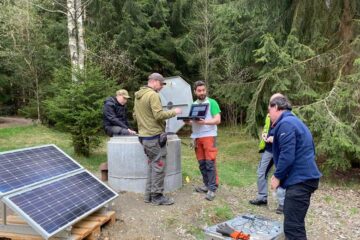Toyota-Hino Fuel Cell Bus to Serve Centrair and Vicinity

The effort is part of a fuel cell demonstration program of the Ministry of Economy, Trade and Industry's (METI's) Japan Hydrogen & Fuel Cell Demonstration Project (JHFC) and is intended to provide TMC and others with data necessary for the commercialization of fuel cell hybrid buses.
Specifically, the FCHV-BUS (short for „fuel cell hybrid vehicle – bus“) will cover the entire „Tokoname Bus Route“, from the „Chitahanda“ stop to the route's terminal „Centrair“ stop, as well as a circular route on the airport's man-made island. The bus will be operated by Chitanoriai Co., Ltd. (Chitanoriai), with which TMC and Hino teamed up to operate the bus from March 9 to 22 around Centrair as part of the Fuel Cell Vehicle Practical Application Promotion Project of the Ministry of Land, Infrastructure and Transport (MLIT).
Furthermore, with the cooperation of Chubu Sky Support Co., Ltd. (CSS), two units of the FCHV-BUS will be used by CSS to shuttle passengers between Centrair's passenger terminal and airplanes on the tarmac.
The buses will be fueled at the JHFC Centrair Hydrogen Station, which will be set up within Centrair as part of the JHFC's Demonstration Study of Hydrogen Fueling Facilities for Fuel Cell Vehicles.
For reference
The National Traffic Safety and Environment Laboratory, which serves as the main institution conducting research for the Fuel Cell Vehicle Practical Application Promotion Project of the MLIT, made an appeal to private companies in January 2006 to find companies interested in public road-testing of fuel cell buses. TMC and Hino jointly responded and were selected.
The Japan Automobile Research Institute, which is promoting the JHFC under METI, made an appeal in April of 2006 for third party participant companies and organizations to run a fleet of fuel cell vehicles. TMC and Hino responded jointly and were selected.
Media Contact
Weitere Informationen:
http://www.toyota.deAlle Nachrichten aus der Kategorie: Unternehmensmeldungen
Neueste Beiträge

Uranimmobilisierende Bakterien im Tongestein
Mikrobielle Reduktion verringert Mobilität von Uranverbindungen. Bei der Konzeption von Endlagern für hochradioaktive Abfälle in tiefen geologischen Schichten müssen verschiedene Faktoren sorgfältig berücksichtigt werden, um ihre langfristige Sicherheit zu gewährleisten….

Erstmals 6G-Mobilfunk in Alpen getestet
Forschende der Universität Stuttgart erzielen leistungsstärkste Verbindung. Notrufe selbst in entlegenen Gegenden absetzen und dabei hohe Datenmengen in Echtzeit übertragen? Das soll möglich werden mit der sechsten Mobilfunkgeneration – kurz…

Neues Sensornetzwerk registriert ungewöhnliches Schwarmbeben im Vogtland
Das soeben fertig installierte Überwachungsnetz aus seismischen Sensoren in Bohrlöchern zeichnete Tausende Erdbebensignale auf – ein einzigartiger Datensatz zur Erforschung der Ursache von Schwarmbeben. Seit dem 20. März registriert ein…





















